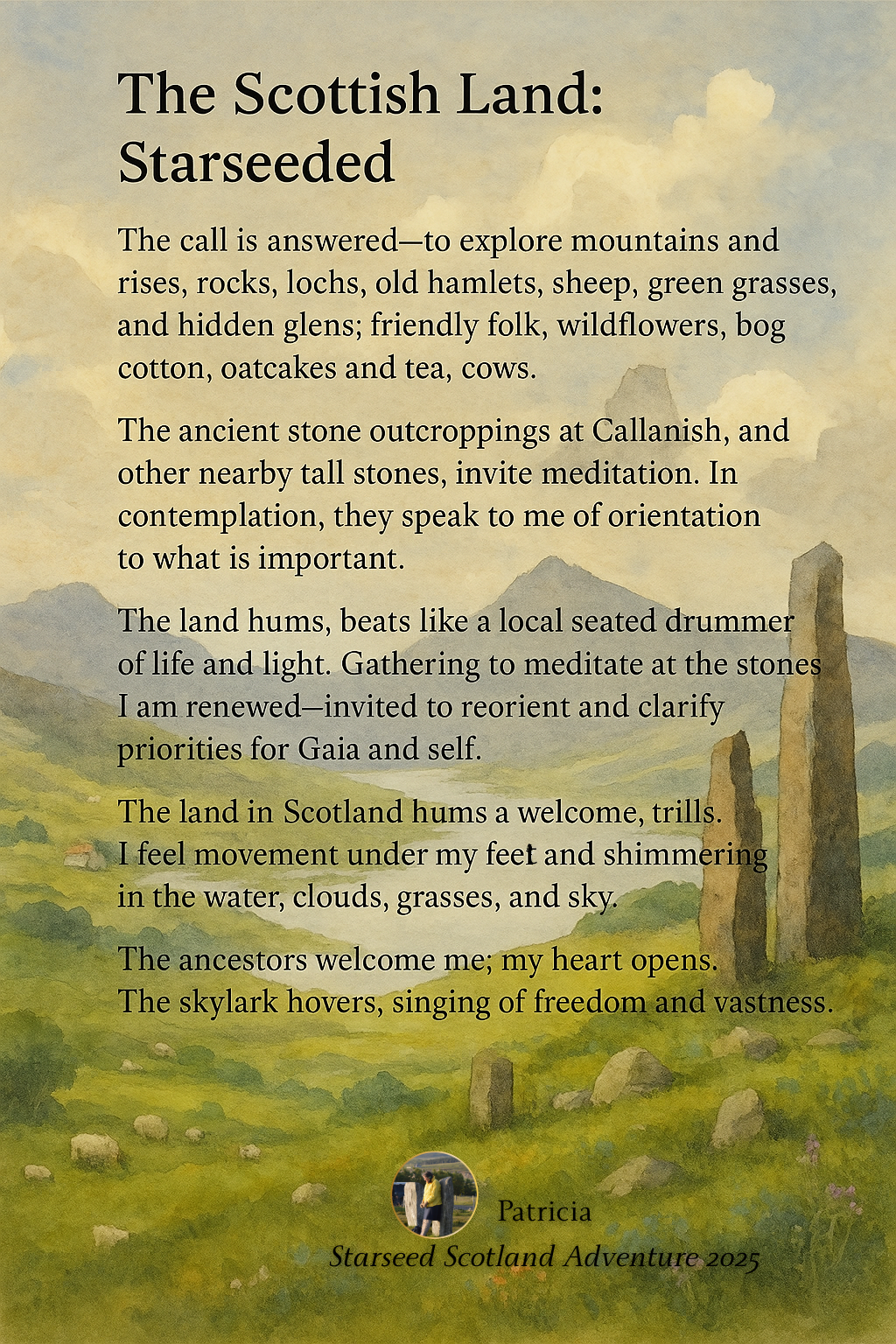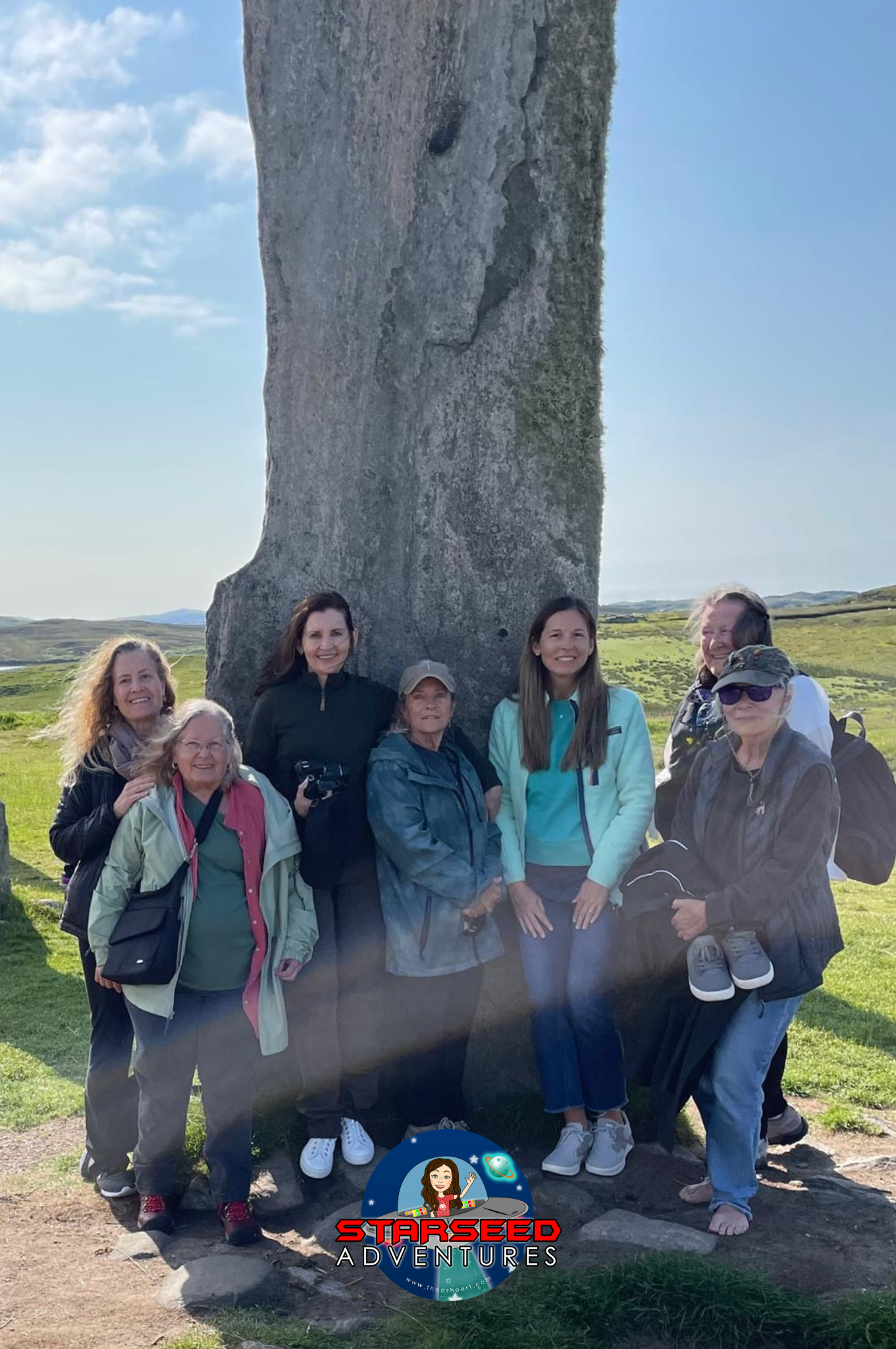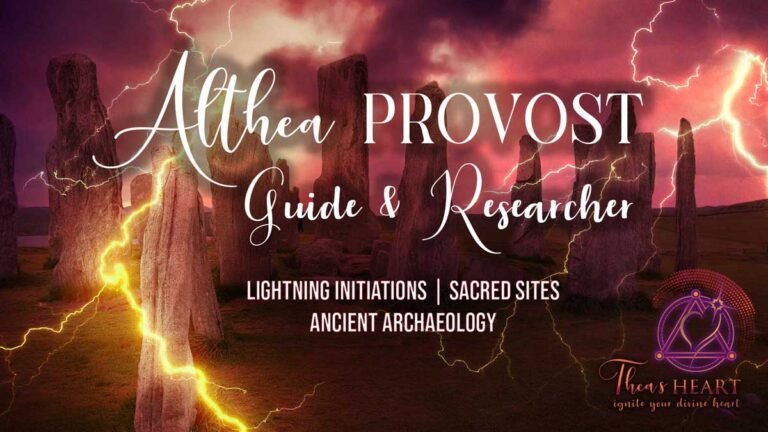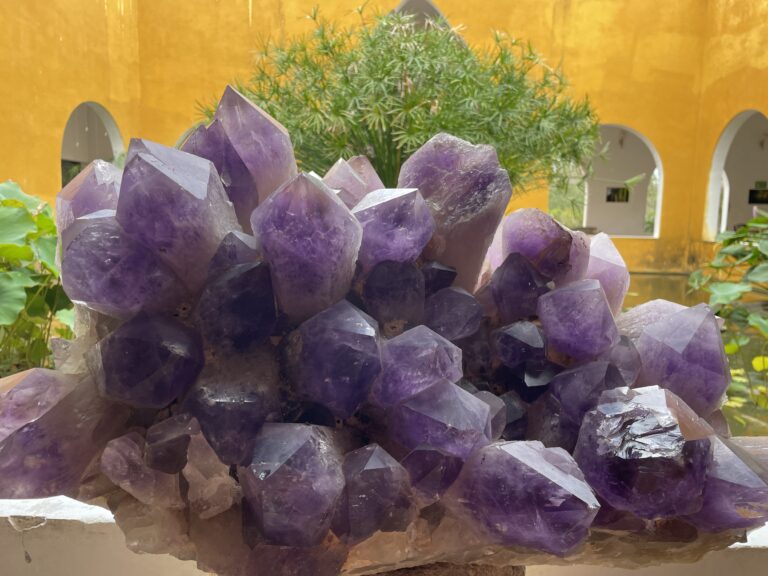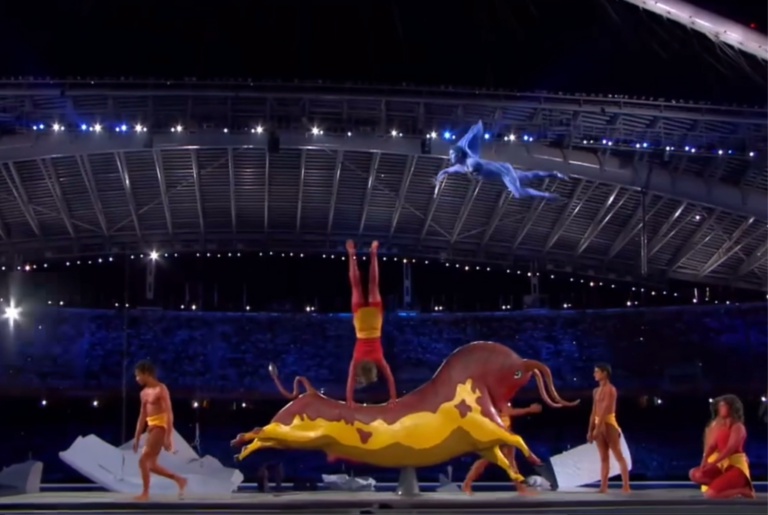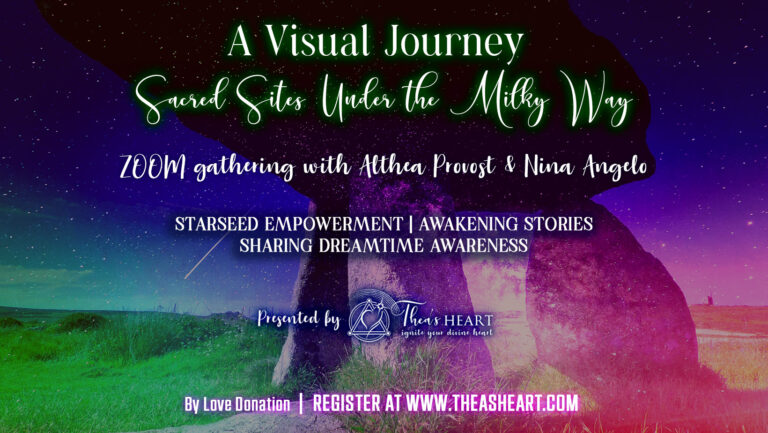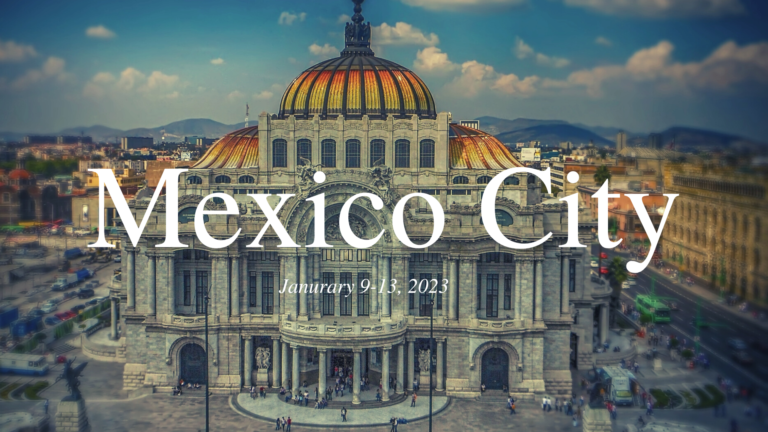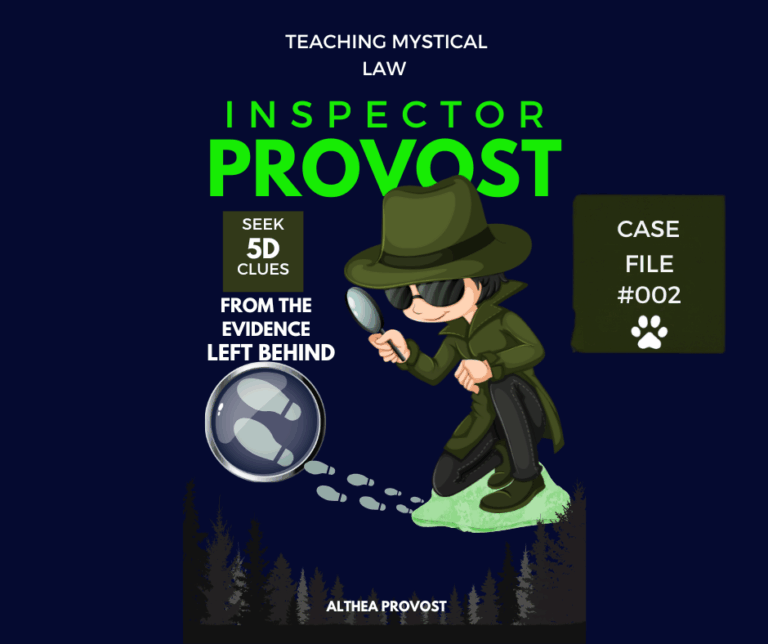Enter the Great Circle
Awaiting our exploration, the standing stones of Callanish I, erected in the late Neolithic era, have been used for rituals for at least 1500 years. This megalithic complex is not merely a single entity, but a constellation—stone circles, arcs, alignments, and solitary pillars, 26 sites in total, each whispering its own ancient tale.
At the heart of the site, a ring of thirteen stones under 38 feet in diameter embracing a single monolith—a rudder-shaped pillar rising nearly 16 feet above ground and weighting an estimated seven-tons. It stands offset, just under three feet west of center, its broad face aligned almost perfectly north-south. It’s awe-inspiring to imagine Neolithic hands carving into the Hebridean soil, heaving a monolith into a socket deep enough to defy time and Atlantic storm—rooted so firmly that even the island’s fiercest winds couldn’t shake it.
The Sailor of Stone and Stars
The bedrock of our understanding of Callanish was shaped by an Irish naval officer with an eye for the stars and a theodolite in hand. In 1909, while charting waters off the Isle of Lewis, Boyle Somerville was grounded by winter gales—an earthly twist of fate that led him inland to the silent stones. There, among windswept moors, he began to survey Callanish with the precision of a mariner, the specialized skills of a hydrographic surveyor who measures oceans and the curiosity of an astronomer.
Armed with theodolite and chain, he measured not just distances but destinies, discerning alignments others had overlooked. His 1913 publication in the Journal of the British Astronomical Association marked the first claim that some stones followed the moon’s long wander across the sky—an insight no one had dared suggest before.
A decade later, in Archaeologia (1923), Somerville deepened his vision, tracing solar paths through the stone sentinels with the same precision he once applied to nautical charts. His fieldwork and celestial observations cemented his place as a pioneer of archaeoastronomy. Having retired as Vice Admiral, he turned full sail toward archaeology, surveying Neolithic marvels like Drombeg Stone Circle in County Cork—a site still humming with ancient ritual. There, he became the first to scientifically document its alignment with the winter solstice sunset. We stepped into that legacy during our Starseed Ireland Adventure in 2018, joining the continuum of tradition alongside our guest author Anthony Murphy. It was here, after our energy work concluded, a lone bird hovered over Murphy who was in the center of Drombeg circle, a magical moment of synchronicity witnessed.
People like Sommerville laid foundational paths, often sparking early curiosity about sacred landscapes and their energetic resonance. Authors like Murphy give those paths voice and volume, threading research into cultural memory. And adventurers and researchers like myself—guiding, writing, and holding space for reflection—weave their legacy into lived experience. We don’t just teach; we activate the sites, echoing ancient wisdom through modern footsteps.
The Solstice Experience: Highlights from Callanish I
As paths cross—through travel, shared ritual, and synchronicity—knowledge is not merely preserved. It is transfigured, reborn with every voice that dares to carry it forward. That is the power of the sacred: always ancient, always new.
Throughout our stay, we returned to Callanish more than once, but this solstice evening would mark our final encounter. I knew intuitively I had to return—despite a celebration underway back at our lodging—I committed wholeheartedly to the calling. Others felt the call too. We packed up the food and climbed into the Starseed van for the 30-minute drive.
As we arrived, our group dispersed into the Great Circle, each person gravitating toward a stone, settling in silence, slipping inward. After a brief but unsuccessful search for an open portable bathroom, I too found my place, pausing to snap a few photos before falling into deep quiet. Just like my first visit three years earlier, I was able to easily drop into a timeless state but unable to map my surroundings or orient myself to the cardinal landscape afterward. I remember the beginning and the end events with crystalline clarity—but the middle? I was far, far away. Where, exactly, I’ve yet to retrieve.
And so I attempt to bring these insights to life—for you, the curious souls, lifelong learners, storytellers, guardians of memory, and stewards of place—those who look beyond the physical form to glimpse the eternal within.
A Circle of Strangers, a Web of Connection
Looking down the central avenue, I searched for Sandy—an elderly man and familiar stranger shown to me in vision earlier that evening—and there he was, approaching. We locked eyes, smiling in acknowledgment of a commitment kept. I turned away to resettle myself, and when I glanced back, he stood just outside the circle. With a nod to enter, I encouraged him to enter. He stepped quietly into the open space to my left and prepared for his own inward journey.
Nearby, a group of locals with beers had gathered near the western avenue to witness the sunset. To honor the space being created, I worked energetically—etherically—and they responded, softening into reverence. A hand drummer arrived, followed by two women with crystal singing bowls who placed themselves by the monolith. Three more strangers joined—including a young man with a dog resembling a white Pyrenees. Alan, another stranger, passed out hand-shakers to some of our group. And somewhere in that weaving of presence, I was drawn to the western avenue—not driven by thought, but by inner guidance—to welcome the unseen ships. Then I returned to the circle.
Then, I lost time.
The Two Suns
As the ceremony drew to a close, I opened my inner vision and saw it: a massive, sunlike brilliance hovering directly above my crown. The physical sun, I knew, was southwest, casting warm rays across the right side of my face—but this light was different. Invisible to the naked eye, its steadfast presence two or three handwidths above me, bright and persistent. I opened my eyes to search the sky—nothing. I turned toward the southwest sun, confirming its position. Two suns. Two distinct energies.
I closed my eyes again and felt the ceremony come to its natural close. When I looked around, Sandy still beside me exclaimed, “Wow, did you do that?”—or something close. I smiled. I hadn’t done anything, but I would have enjoyed hearing what he had experienced.
The Earth Speaks in Motion and Hum
Around 9:30 p.m. BST, the Pleiades set—though we couldn’t see the stars in the endless northern twilight. Some wished to linger to experience the liminal light of the 10:39 sunset, while others felt complete, ready to return. Before we departed, I thanked everyone on behalf of our group, and as we made our way to Stornoway, I was asked to share my experience and invited the others to share theirs.
One starseed hadn’t removed her shoes and struggled with her feet hurting from the powerful current moving through her. Four described feeling motion beneath them—figure-eight patterns, vertical and horizontal. Another described a slow, rolling wave. The wave sensation was reported both within the circle and along the southern avenue, where the energy felt even stronger. One traveler compared it to the wave she’d felt during our Starseed Egypt Adventure (2022) at the Temple of Isis in Aswan. The Callanish wave, she said, was subtler. Yet upon touching the stone and self-quieting in reverence, she felt a hum, like Earth’s engine in neutral: soft crescendos, like a buzzing bee coursing through her body.
I didn’t feel the hum that night, but her words echoed others I’ve heard—from Mount Shasta to Sedona, Glastonbury to Stonehenge, people describe a low, rhythmic pulse beneath their feet, like the Earth’s heartbeat.
Energy at the Edge
She also noted that the energy outside the central circle felt stronger. Interestingly, she’s not alone. In 1983, engineer Charles Brooker conducted a magnetometer survey at the Rollright Stones in England. He found that the geomagnetic field inside the circle was significantly lower than outside. The magnetic flow spiraled inward at the entrance like a vortex.
At Avebury, electrode-based studies have shown that telluric ground currents—natural electrical flows within the Earth—are drawn into the stone circle, particularly at sunrise. These currents appear to concentrate within the circle, resulting in energy levels roughly twice as high as those in the surrounding land. Avebury’s original design is that of a henge: a circular ditch and bank, enclosed by a large embankment. Similarly, in 1909, Somerville observed remnants of a rock wall near the Callanish stone circle, suggesting the site may have once been enclosed—though this feature is likely a later addition rather than part of the original structure.
Meanwhile, Pierre Mereux, an electrical engineer studying the Carnac stones in France, found that energy pulsed strongest near the base of the stones, fading with distance. Like coiled wires or solenoids, the stones seemed to gather and release energy in rhythmic waves.
Together, these findings suggest that the outer edges of stone circles may amplify or concentrate natural earth energies, interacting with geomagnetism and perhaps even consciousness itself. Some liken it to the operation of a particle collider, where forces are focused, accelerated, and spun into something beyond ordinary understanding.
Myth, Memory, and the Shining One
This naturally leads to a legend first recorded in 1695 by Scottish travel writer Martin Martin, who wrote that Callanish was a pre-Christian site of “heathen” worship. Local folk tradition expands on this—telling of the cuckoo’s call, a herald to the arrival of a shining one who walks the stone-lined avenue in radiant form. Whether a sun deity, a fertility spirit, Apollo from Greece, or Lugh, the Celtic god of light, crossing from Ireland—the mythic figure strides in with the first light of midsummer solstice, etched into the very soul of this sacred landscape.
For me, perhaps it is less about one name, and more about what is remembered through presence. Sites like Callanish seem to awaken the link between Earth and stars—illuminating our energy fields, reminding us we are first and foremost light-bearers to the Earth. If we align our intentions—carefully, honestly, and with reverence—something activates.
Of Stars and Direction
I’ll close, fittingly, with Somerville and the Greeks. That sharp-minded mariner once posed a deceptively simple question in his work: What is North? How do we truly know a cardinal direction? If cast upon open sea with no land in sight, how can one orient the self?
We know because of the stars.
The heavens are our compass, and always have been. Celestial bodies teach us direction—not only across waters, but through time and spirit.
So it feels resonant that I was called to gather a circle of starseeds at Callanish—just after the 18.6-year lunar standstill cycle, and just before the setting of the Pleiades—to complete our solstice ceremony beneath a turning sky.
In that spirit, I offer Somerville’s closing nod to the ancient world—his reference to Diodorus Siculus and the Hyperborean Isle (considered by many as the Isle of Lewis):
“It is also said that in this Island (i.e., that of the Hyperboreans) the moon appears very near to the earth; that certain eminences of a terrestrial form are plainly seen upon it; that the god (Apollo) visits the Island once in a course of nineteen years, in which period the stars complete their revolutions, and for this reason the Greeks distinguish the Cycle of nineteen years by the name of the Great Year. During the season of his appearance, the god plays upon the harp and dances every night from the Vernal Equinox to the rising of the Pleiades, pleased with his own successes.” — Diodorus Siculus, Book II.47
For our circle of starseeds, this myth feels more than metaphor—it mirrors lived experience. We are those who know that knowledge is not static; it flows, evolves, and reverberates across time.
The map, as ever, comes alive only when it is walked—through participation, conversation, pilgrimage, study, and quiet reflection. True knowledge is never lost; it threads itself into the next journey, the next mind, the next generation.
With every story shared, every offering placed, every breath drawn in sacred presence—we pass the torch.
We become student and steward. Guide and pilgrim. More illuminated than before.
Works Consulted – a traceable lineage that keeps the sacred visible and vibrant.
Graeme (2024) Fascinating stories from the Calanais Standing Stones, Scotland’s Stories. Available at: https://scotlands-stories.com/fascinating-stories-from-the-calanais-standing-stones/ (Accessed: 02 July 2025).
Lacey, B. (2008). Review Article: The Irish archaeological studies of Boyle Somerville, 1909-1936. The Journal of the Royal Society of Antiquaries of Ireland, 138, 147–158. http://www.jstor.org/stable/27920493
Silva, F. (no date) They’re Alive! Megalithic sites are more than just stone., Energy at megalithic sites reveals they are more than just stones. Available at: https://invisibletemple.com/extra/megalithic-sites-more-than-stone.html (Accessed: 02 July 2025).
Somerville, B. (1923). Orientation in Prehistoric Monuments of the British Isles: A Study in Archaeoastronomy. Archaeologia, 72, 37–60. Citing https://onlinebooks.library.upenn.edu/webbin/serial?id=archaeologia
Sommerville, B. (1913) Prehistoric Monuments in the Outer Hebrides. Available at: https://www.jstor.org/stable/2843231 (Accessed: 03 July 2025). Citing scanned JBAA, Vol. 23, 1913, pp. 185–192.
Cite my article
Provost, A. (2025) Enter the Great Circle, Thea’s Heart.com. Available at: https://theasheart.com/enter-the-great-circle/.
©2025 Thea’s Heart, LLC® – All Rights Reserved.
Step into the windswept moors of Callanish for a solstice journey that blends ancient myth, celestial alignments, and embodied spiritual experience. From the pioneering insights of Vice-Admiral Boyle Somerville to the living energy sensed beneath stone, this immersive narrative illuminates how sacred sites awaken memory and meaning across time. A timeless dance between Earth and sky, ritual and revelation.
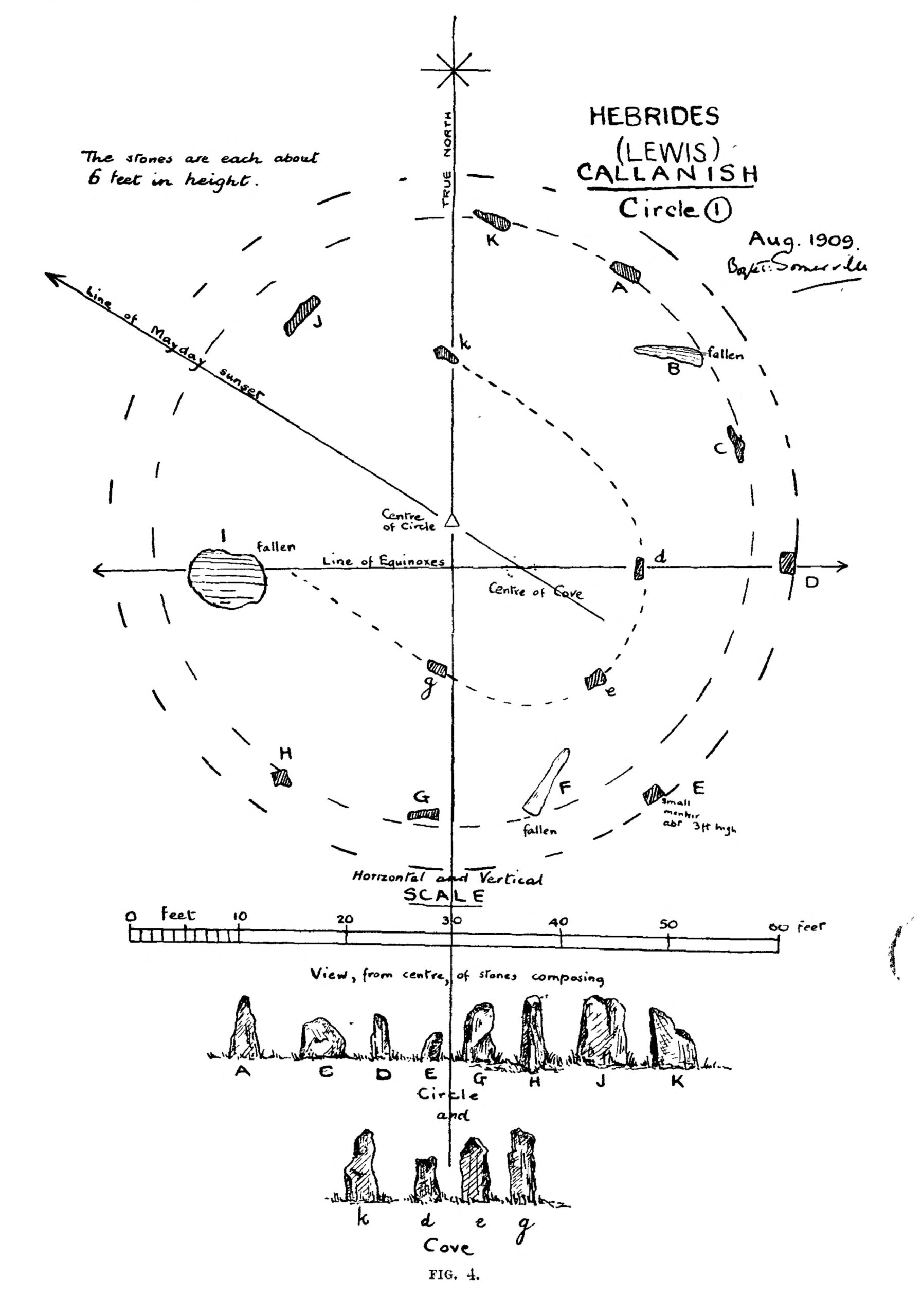
📐 Boyle Somerville’s Survey of Callanish I (1909) In the summer of 1909, Vice-Admiral Boyle Somerville, a distinguished naval hydrographer and early archaeoastronomer, conducted a meticulous theodolite and chain survey of the Callanish I stone circle on the Isle of Lewis. His plan, plotted at a scale of 1 inch to 8 feet, revealed the monument’s complex geometry: a central circle of 13 standing stones surrounding a tall monolith and chambered tomb, with four stone avenues radiating outward.
Somerville’s pioneering work proposed that these alignments were not random but intentionally oriented toward celestial events—particularly the rising and setting points of the moon and stars. He was among the first to suggest that Callanish I might have been used for lunar observations, predating later theories about the site’s connection to the 18.6-year lunar standstill cycle.
His survey remains a foundational reference in archaeoastronomy, blending scientific precision with a deep curiosity about prehistoric cosmology.
What our starseed has to say.
